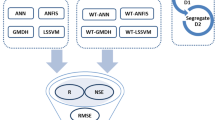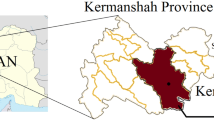Abstract
Prediction of groundwater depth (GWD) is a critical task in water resources management. In this study, the practicability of predicting GWD for lead times of 1, 2 and 3 months for 3 observation wells in the E**a Basin using the wavelet-artificial neural network (WA-ANN) and wavelet-support vector regression (WA-SVR) is demonstrated. Discrete wavelet transform was applied to decompose groundwater depth and meteorological inputs into approximations and detail with predictive features embedded in high frequency and low frequency. WA-ANN and WA-SVR relative of ANN and SVR were evaluated with coefficient of correlation (R), Nash-Sutcliffe efficiency (NS), mean absolute error (MAE), and root mean squared error (RMSE). Results showed that WA-ANN and WA-SVR have better performance than ANN and SVR models. WA-SVR yielded better results than WA-ANN model for 1, 2 and 3-month lead times. The study indicates that WA-SVR could be applied for groundwater forecasting under ecological water conveyance conditions.





Similar content being viewed by others
References
Adamowski JF (2008) Development of a short-term river flood forecasting method for snowmelt driven floods based on wavelet and cross-wavelet analysis. J Hydrol 353(3):247–266
Adamowski J, Chan HF (2011) A wavelet neural network conjunction model for groundwater level forecasting. J Hydrol 407(1):28–40
Anderson MP, Woessner WW (1992) Applied groundwater modeling: simulation of flow and advective transport, vol 4. Gulf Professional Publishing
Bayram A, Kankal M, Onsoy H (2012) Estimation of suspended sediment concentration from turbidity measurements using artificial neural networks. Environ Monit Assess 184(7):4355–4365
Behzad M, Asghari K, Coppola EA Jr (2009) Comparative study of SVMs and ANNs in aquifer water level prediction. J Comput Civ Eng 24(5):408–413
Boadu FK (1997) Rock properties and seismic attenuation: neural network analysis. Pure Appl Geophys 149(3):507–524
Cannas B, Fanni A, See L, Sias G (2006) Data preprocessing for river flow forecasting using neural networks: wavelet transforms and data partitioning. Phys Chem Earth A/B/C 31(18):1164–1171
Chang CC, Lin CJ (2011) LIBSVM: a library for support vector machines. ACM Trans Intell Syst Technol 2(3):27
Chen JS, Wang JY, Zhao X, Sheng X, Gu W, Chen L, Su Z (2004) Study of groundwater supply of the confined aquifers in the E** Basin based on isotopic methods. Geol Rev 50(6):649–658
Coulibaly P, Baldwin CK (2005) Nonstationary hydrological time series forecasting using nonlinear dynamic methods. J Hydrol 307(1):164–174
Cui Y, Shao J (2005) The role of groundwater in arid/semiarid ecosystems, Northwest China. Groundwater 43(4):471–477
Daubechies I (1992) Ten lectures on wavelets. Philadelphia Soc Ind Appl Math 61:198–202
Deka PC, Prahlada R (2012) Discrete wavelet neural network approach in significant wave height forecasting for multistep lead time. Ocean Eng 43:32–42
Deo RC, Tiwari MK, Adamowski JF, Quilty MJ (2016) Forecasting effective drought index using a wavelet extreme learning machine (W-ELM) model. Stoch Env Res Risk A:1–30. https://doi.org/10.1007/s00477-016-1265-z
Fan ZL, Chen YN, Li HP (2008) Determination of suitable ecological groundwater depth in arid areas in northwest part of China. J Arid Land Resour Environ 22(2):1–5 (in Chinese)
Feng Q, Liu W, Su YH, Zhang YW, Si JH (2004) Distribution and evolution of water chemistry in Heihe River basin. Environ Geol 45(7):947–956
Guo QL, Feng Q, Li JG (2009) Environmental changes after ecological water conveyance in the lower reaches of Heihe River, northwest China. Environ Geol 58(7):1387–1396
Haykin S (1999) Neural networks: a comprehensive foundation. Prentice Hall, NJ
Hsu CW, Chang CC, Lin CJ (2003) A practical guide to support vector classification. National Taiwan University, http://www.csie.ntu.edu.tw/cjlin/papers/guide/guide.Pdf
Izady A, Davary K, Alizadeh A, Nia AM, Ziaei AN, Hasheminia SM (2013) Application of NN-ARX model to predict groundwater levels in the Neishaboor Plain, Iran. Water Resour Manag 27(14):4773–4794
Jha MK, Sahoo S (2015) Efficacy of neural network and genetic algorithm techniques in simulating spatio-temporal fluctuations of groundwater. Hydrol Process 29(5):671–691
** XM, Michel S, Jan C, Su ZB, Hu GC (2010) Correlation between annual runoff in the Heihe River to the vegetation cover in the E**a Oasis (China). Arid Land Res Manag 24:31–41
Krishna B, Satyaji Rao YR, Vijaya T (2008) Modelling groundwater levels in an urban coastal aquifer using artificial neural networks. Hydrol Process 22(8):1180–1188
Kumar D, Prasad RK, Mathur S (2013) Optimal design of an in-situ bioremediation system using support vector machine and particle swarm optimization. J Contam Hydrol 151:105–116
Kurup PU, Dudani NK (2002) Neural networks for profiling stress history of clays from PCPT data. J Geotech Geoenviron 128(7):569–579
Le Maitre DC, Scott DF, Colvin C (1999) Review of information on interactions between vegetation and groundwater. Water SA 25(2):137–152
Lin GF, Chen GR, Wu MC, Chou YC (2009) Effective forecasting of hourly typhoon rainfall using support vector machines. Water Resour Res 45(8):1–11
Lohani AK, Goel NK, Bhatia KKS (2011) Comparative study of neural network, fuzzy logic and linear transfer function techniques in daily rainfall-runoff modelling under different input domains. Hydrol Process 25(2):175–193
Maheswaran R, Khosa R (2012a) Wavelet-Volterra coupled model for monthly stream flow forecasting. J Hydrol 450-451:320–335
Maheswaran R, Khosa R (2012b) Comparative study of different wavelets for hydrologic forecasting. Comput Geosci 46(3):284–295
Maheswaran R, Khosa R (2013) Long term forecasting of groundwater levels with evidence of non-stationary and nonlinear characteristics. Comput Geosci-UK 52(1):422–436
Mohanty S, Jha MK, Kumar A, Sudheer KP (2010) Artificial neural network modeling for groundwater level forecasting in a River Island of Eastern India. Water Resour Manag 24(9):1845–1865
Mohanty S, Jha MK, Raul SK, Panda RK, Sudheer KP (2015) Using artificial neural network approach for simultaneous forecasting of weekly groundwater levels at multiple sites. Water Resour Manag 29:5521–5532
Moosavi V, Vafakhah M, Shirmohammadi B, Behnia N (2013) A wavelet-ANFIS hybrid model for groundwater level forecasting for different prediction periods. Water Resour Manag 27(5):1301–1321
Moriasi DN, Arnold JG, Van Liew MW, Bingner RL, Harmel RD, Veith TL (2007) Model evaluation guidelines for systematic quantification of accuracy in watershed simulations. Trans ASAE 50(3):885–900
Naumburg E, Mata-Gonzalez R, Hunter RG, Mclendon T, Martin DW (2005) Phreatophytic vegetation and groundwater fluctuations: a review of current research and application of ecosystem response modeling with an emphasis on Great Basin vegetation. Environ Manag 35(6):726–740
Nourani V, Mogaddam AA, Nadiri AO (2008) An ANN-based model for spatiotemporal groundwater level forecasting. Hydrol Process 26:5054–5066
Pal M (2006) Support vector machines-based modelling of seismic liquefaction potential. Int J Numer Anal Methods Geomech 30(10):983–996
Rathinasamy M, Adamowski J, Khosa R (2013) Multiscale streamflow forecasting using a new Bayesian Model Average based ensemble multi-wavelet Volterra nonlinear method. J Hydrol 507(25):186–200
Rathinasamy M, Khosa R, Adamowski J, Partheepan G, Anand J, Narsimlu B (2014) Wavelet-based multiscale performance analysis: An approach to assess and improve hydrological models. Water Resour Res 50(12):9721–9737
Sang YF (2012) A practical guide to discrete wavelet decomposition of hydrologic time series. Water Resour Manag 26(11):3345–3365
Santhi C, Arnold JG, Williams JR, Dugas WA, Srinivasan R, Hauck LM (2001) Validation of the SWAT model on a large river basin with point and non-point sources. J Am Water Resour Assoc 37(5):1169–1188
Shiri J, Kisi O, Yoon H, Lee KK, Nazemi AH (2013) Predicting groundwater level fluctuations with meteorological effect implications-a comparative study among soft computing techniques. Comput Geosci-UK 56:32–44
Si JH, Feng Q, Wen XH, Su YH, ** HY, Chang ZQ (2009) Major ion chemistry of groundwater in the extreme arid region northwest China. Environ Geol 57(5):1079–1087
Soylu ME, Istanbulluoglu E, Lenters JD, Wang T (2011) Quantifying the impact of groundwater depth on evapotranspiration in a semi-arid grassland region. Hydrol Earth Syst Sci 15(3):787–806
Suryanarayana C, Sudheer C, Mahammood V, Panigrahi BK (2014) An integrated wavelet-support vector machine for groundwater level prediction in Visakhapatnam, India. Neurocomputing 145:324–335
Tapoglou E, Karatzas GP, Trichakis IC, Varouchakis EA (2014) A spatio-temporal hybrid neural network-Kriging model for groundwater level simulation. J Hydrol 519:3193–3203
Van Liew MW, Arnold JG, Garbrecht JD (2003) Hydrologic simulation on agricultural watersheds: choosing between two models. Trans ASAE 46(6):1539–1551
Vapnik VN, Vapnik V (1998) Statistical learning theory, vol 1. Wiley, New York
Wang WS, Ding J (2003) Wavelet network model and its application to the prediction of hydrology. Sci Nat 1(1):67–71
Wang P, Yu JJ, Zhang Y, Fu GB, Min LL, Ao F (2011) Impacts of environmental flow controls on the water table and groundwater chemistry in the E**a Delta, northwestern China. Environ Earth Sci 64(1):15–24
Wen XH, Wu YQ, Su JH, Zhang YH, Liu F (2005) Hydrochemical characteristics and salinity of groundwater in the E**a Basin, Northwestern China. Environ Geol 48(6):665–675
Wen XH, Feng Q, Yu HJ, Wu J, Si JH, Chang ZQ, ** HY (2014) Wavelet and adaptive neuro-fuzzy inference system conjunction model for groundwater level predicting in a coastal aquifer. Neural Comput Applic 26:1–13
Wu XM, Shi SS, Li ZH (2002) The study on the groundwater flow system of E**a basin in lower reaches of the Heihe River in Northwest China. Hydrogeol Eng Geol 1:16–20 (in Chinese)
Wu MC, Lin GF, Lin HY (2014) Improving the forecasts of extreme streamflow by support vector regression with the data extracted by self-organizing map. Hydrol Process 28(2):386–397
** HY, Feng Q, Liu W, Si JH, Chang ZQ, Su YH (2010a) The research of groundwater flow model in E**a Basin, Northwestern China. Environ Earth Sci 60(5):953–963
** HY, Feng Q, Si JH, Chang ZQ, Cao SK (2010b) Impacts of river recharge on groundwater level and hydrochemistry in the lower reaches of Heihe River Watershed, northwestern China. Hydrogeol J 18(3):791–801
**e Q (1980) Regional hydrogeological survey report of the People’s Republic of China (1: 200 000): E**a K-47-[24] Jiuquan. (in Chinese)
Zhang YC, Yu JJ, Wang P, Fu GB (2011) Vegetation responses to integrated water management in the E**a basin, northwest China. Hydrol Process 25(22):3448–3461
Acknowledgments
This research was supported by the National Natural Sciences Foundation of China (31370466). The data were acquired from obtained from Chinese Meteorological Data Sharing Service System and E**a Banner Water Authority. Dr. RC Deo appreciates the support from University of Southern Queensland that provided the Research Activation Incentive Scheme grant (RAIS, July – September 2015) provided to establish collaborative links with the Cold and Arid Regions Environmental and Engineering Institute Chinese at Chinese Academy of Sciences. We thank the Reviewer, Associate Editor and the Editor-In-Chief for their critical comments for this research paper.
Author information
Authors and Affiliations
Corresponding authors
Rights and permissions
About this article
Cite this article
Yu, H., Wen, X., Feng, Q. et al. Comparative Study of Hybrid-Wavelet Artificial Intelligence Models for Monthly Groundwater Depth Forecasting in Extreme Arid Regions, Northwest China. Water Resour Manage 32, 301–323 (2018). https://doi.org/10.1007/s11269-017-1811-6
Received:
Accepted:
Published:
Issue Date:
DOI: https://doi.org/10.1007/s11269-017-1811-6




